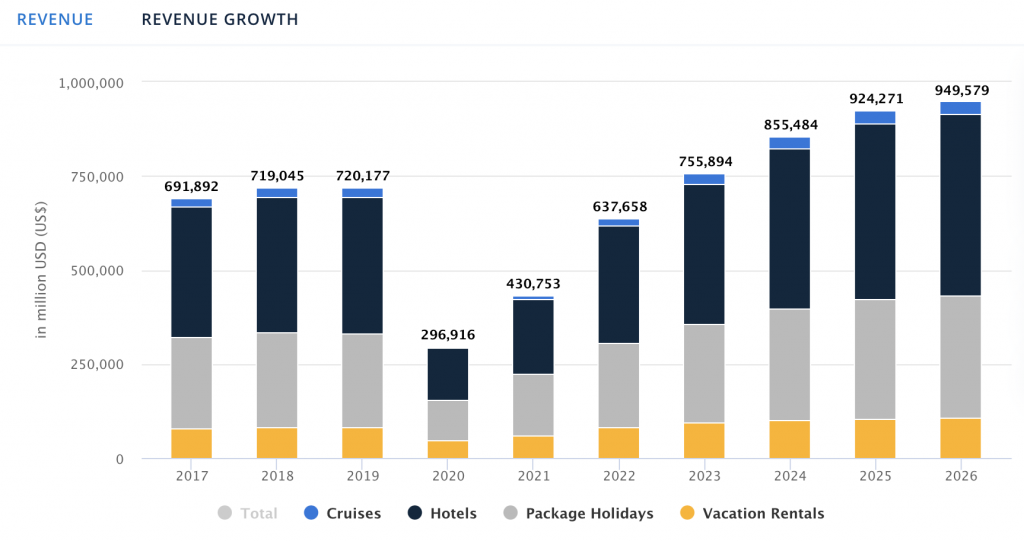As the industry regains its footing, these travel marketing tips can help you continue to grow in 2022 and beyond.
Here, you’ll find:
- How travel marketing now is different from years past
- Ways to keep your customers front and center
- Tips for adding wiggle room into your plans
- How to make sure your travel campaigns are optimized
It’s no secret that the pandemic hit the travel industry hard. Sales plummeted across the board, from cruises and flights to hotels and vacation rentals.

Travel industry revenue data and projections (Image via Statista)
The good news: data shows things are starting to bounce back. In fact, projections show revenue will continue to climb and will surpass 2019 numbers by 2023.
Until then, we’ve laid out the strategies marketers can explore to keep the industry afloat amid all the uncertainty as people regain their confidence in travel.
1. Lead with authenticity
People travel for a variety of reasons: work, adventure, visiting loved ones, or just to get out of their daily routine. But even though many travelers are looking to escape from the news cycle or constant pandemic worries, that doesn’t mean your company should ignore our current reality.
Rather than completely sweeping the last year and a half under the rug or pretending everything is back to normal, brainstorm how you can inject authenticity into your marketing.
From the imagery you use to your copy and messaging, see how you can acknowledge the current moment we’re in — an admittedly weird gray area when it comes to travel rules and precautions — in a way that’s creative and honest.

While you want to head into 2022 as prepared as possible, your best-laid plans could very well go out the window. (Image via Unsplash)
2. Center the customer
Let’s be real: travel can be both a wonderful, life-changing experience and a complicated logistical nightmare. With more unpredictable passengers and stretched-thin teams, coordinating a trip can sometimes cause you to need a vacation from your vacation.
One way to make your travel marketing stand out is by centering the customer experience. Rather than simply focusing on the specific products or services you offer, highlight the problem your business aims to solve.
If you’re stumped on how to go about this, start by asking questions like:
- What does our target audience want from us?
- How do we improve someone’s quality of life?
- What is the mission at the core of our brand?
- What do happy customers say about us?
3. Keep wiggle room in your plan
Even if you’ve only been in the travel marketing industry a short while, chances are you still know how quickly things can change. So while you certainly want to head into 2022 as prepared as possible, keep in mind that your best-laid plans could very well go out the window.
There are a handful of ways to account for the unexpected when creating your travel marketing plan, including:
- When calculating KPIs, create regular goals and stretch goals
- Make a note of any algorithm or industry changes that could affect your Google Analytics as they happen
- Focus on SEO, which is less vulnerable to hiccups
- Regularly reassess your target audience to see if their demographic, budget, or needs have changed
4. Double-check your keywords
When it comes to both paid search campaigns and SEO strategies, keywords are, well, key. And, for better or worse, keyword research isn’t a one-and-done job.
Especially with how much the travel industry has changed over the past several months, it’s a good idea to make sure you’re on the right path and know what keywords people are using to find your business.
From there, you can make sure your keyword list is optimized, in line with your budget, and that your pages have high-quality content to help them rank.
Pro tip: There are plenty of keyword research tools at your disposal, both free of charge and for a fee. Check out sites like AnswerThePublic, Ahrefs, and SEMrush.

If you’re not regularly testing and monitoring your performance, you’re more likely to get scooped by the competition. (Image via Unsplash)
5. Understand the industry trends
Along with the keyword tools above, travel marketers can also benefit from sites like Google Trends. That’s because factors like region, seasonality, and time of year play a huge role when it comes to travel.
Dig into your data. What keywords are people using and when? What time of year do certain pages get the most traffic, and why?
Once you have a firm grasp on how these industry trends affect your business, you can be more intentional about how, where, and when you position your offerings through marketing.
6. Lean on visuals
The tie-dye sky of a Hawaiian sunset, the bright blue water off the Amalfi coast, the breathtaking exterior of the Taj Mahal — sightseeing is one of the top reasons people choose to travel.
No matter what your travel offering is, don’t make visuals an afterthought. Having professional photos taken, whether you’re an all-inclusive resort, a travel agency, a transportation service or something more, can benefit several aspects of your marketing plan.
Include photos and videos in your social media posts to make them more engaging. You can also create a “virtual tour” if it makes sense for your business. This adds legitimacy to your brand and helps people feel more confident in knowing what to expect before making a purchase.
7. A/B test ads and landing pages
“Set it and forget it” may be an appealing tactic to take with your digital marketing. But if you’re not regularly testing and monitoring your performance, you’re more likely to get scooped by the competition.
Taking the time to A/B test your ads and landing pages will give you peace of mind that your campaigns are optimized and speaking to your target audience as intended.
You can play around with copy, page layout, calls to action (CTAs), imagery, and more, and see what resonates most.

Explore partnering with a complementary brand or a travel influencer who can boost your brand awareness through their sizable following. (Image via Unsplash)
8. Keep the content coming
Back to SEO — with all the ups, downs, and unknowns that remain when it comes to travel, investing in SEO can add a helpful dose of consistency to your marketing plan.
As booking software company Checkfront explains, “With a well-maintained blog, you can establish authority as a destination expert, attract more visitors to your website, and best of all, boost SEO.”
If you’ve got the bandwidth, you can take things a step further with social media partnerships. As we’ve mentioned before, travel is one of the top-performing industries on social media. You can explore partnering with a complementary brand or a travel influencer who can boost your brand awareness through their sizable following.
The takeaway
Travel remained precarious in 2021. Because of this, reports show people are looking ahead to 2022 to plan their big trips and vacations.
Though the future remains uncertain, travel brands can look at this as an opportunity to zoom out on their plans and initiatives and make sure they’re hitting all the right notes with their marketing.
Authenticity will always resonate more than empty platitudes or tone-deaf messaging.
By keeping the customer at the center of your marketing campaigns and being strategic about how you position your travel offering, you can be set up to succeed, no matter what the future of travel brings.

